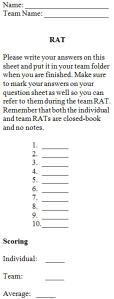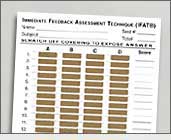Given that the creepy and crawly critters are everywhere as Halloween approaches, I thought this would be a perfect time for me to write a post about RATs. The focus of this post will be RATs, what they are, how I use them, and why they can enhance student learning. Readiness Assurance Tests, or RATs, are brief assessment instruments that I administer at the beginning of each learning sequence (aka module or unit) in my classes to, as their name suggests, assess students’ readiness for the content that they are about to learn. RATs are a component of the Team Based Learning (TBL) that I discussed in my August 2015 post. Please check out this post, “The Power of Student Presentations” to gain a better understanding of TBL, how I am integrating it with IBL, and the nuts and bolts of RATs.
The week before the RAT I tell my students what material they should read to prepare for the RAT. Then on “RAT day” students first take a individual RAT (iRAT). My RATs each have ten multiple choice items with five answer choices. Students are asked to circle their answers on the questions sheet, and to write their answers on a answer sheet, which I collect.

After I collect students’ iRATs, I pass out a immediate feedback assessment technique (ifat) scratch cards to each pre-established team (of 5-8 students).
Next the students’ work collaboratively to answer the questions as teams (tRAT). One person on each team is designated as the scratcher, who scratches the answer that their team agrees on off of their team ifat scratch card (similar in look and feel to a lottery card). If their answer is correct, a star will be in the spot of the answer they selected, and they will earn 10 points on their tRAT. If the answer is not correct, the team members continue to discuss the questions and choose the correct answer. If the correct answer is obtained on the second, third, fourth, or fifth attempt, the team earns five, three, zero, or zero points, respectively on their tRAT. The teams continue to work in this manner for all ten questions.
While students are working on their tRATs I score the iRAT answer sheets. Once everyone has completed the tRAT, I pass back the graded iRAT answer sheets. Students find the average of their iRAT and tRAT scores. This average grade is what I record in my grade book as their final RAT grade for that learning sequence. At this point, I ask students if anyone wishes to appeal any question or wants me to go over any questions. The amazing thing about the process is that through the collaboration and immediate feedback process the student misconceptions and confusions are usually resolved. This whole process typically takes 15-30 minutes.
Initially I was worried about how RATs would go, but I have found that my students actually look forward to RATs. In fact several beg me to add a team component to the end of the unit tests. I have also seen an improvement in student understanding of the material. I think that this is because they are taking responsibility for their learning and reading the chapter before class (to prepare for the RATs). Additionally, the RATs (and other formative assessments that I use) give them immediate feedback so they are able to self-regulate their learning.
If you are interested in learning more about TBL, check out the Team Based Learning website. Also, in order to administer the RATs, you will need to purchase scratch cards (immediate feedback assessment technique, or IFAT cards). This website also includes a “Testmaker” that you can use to write and print your RATs (so they match with the answers on the scratch cards).
